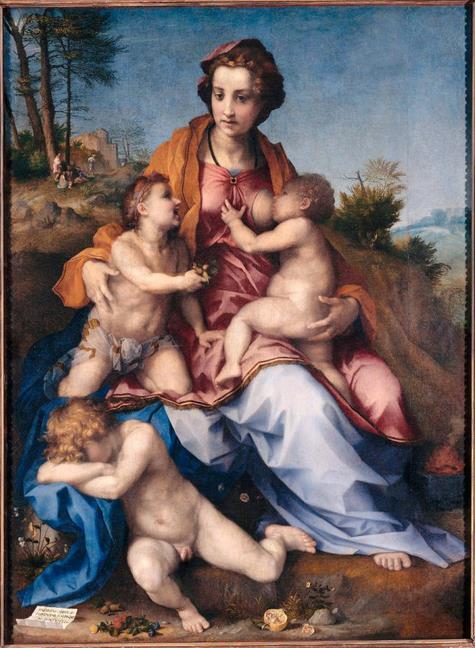


Peter Candid
The Assumption and Coronation of the Virgin Mary
1620
Frauenkirche, Munich, Germany
Below, the apostles find Mary's sarcophagus empty and look up to see her bodily assumption into Heaven. St. Peter kneels at the left in the blue tunic: his keys rest beside the book in front of him. St. Paul stands on the right with the book of his letters. The one beardless figure, standing behind the center of the sarcophagus, should be St. John. The Heaven above them is visualized as an amphitheater of concentric circles, much like the arrangement in Saraceni's 1598
Paradise.
At the top, the Holy Spirit appears as a dove and the Father as a brilliant circle, a metaphor that, like the concentric circles, may reflect an awareness of Dante's Paradiso.
Two allegorical figures sit in the forefront of the lower Heaven. On the right, Charity nurses one infant while another cuddles against her side. (See Figure 1, below.) Behind her head is the one person in the lower Heaven wearing a crown, most likely King David. On the left the artist has placed a figure modeled on
the outsize St. Christopher
who sits in the foreground of Saraceni's Paradise. The figure may represent some such virtue as Fortitude. Noah stands to his left with the ark, and behind Noah is a virgin martyr with a sword.
The upward movement of Mary's body is emphasized in the shape of the cloud and the progression of light and color from the somber tones at the bottom of the frame to the brilliant gold at the top. To the same purpose, Candid presents a point in time just preceding the end of Mary's ascent, when she has come almost far enough to stand beside her son and accept the crown. In this way the Assumption and Coronation come to a completion not on the canvas but in the viewer's anticipation. This effect is quite different from that of medieval sculptures, which typically present the two events in separate registers.
View this image in full resolution.
Read more about the Assumption.
Photographed at the Frauenkirche by Richard Stracke, shared under Attribution-NonCommercial-ShareAlike license.

